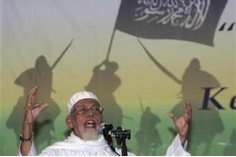
The figure in the image is Abu Bakar Ba’asyir, co-founder and spiritual leader of Jemaah Islamiah.
The horse and rider motif (also in the background) is common in jihadi visual propaganda. The rider emphasizes the element of human agency in jihad, and is a way to enhance the traditional symbol of a horse and flesh out notions of aggression and the call to jihad. The horse-an important symbol in both pre-Islamic Arabia and Islamic culture–has been ascribed with the positive qualities of chivalry, bravery in battle and victory, as evidenced in pre-Islamic poetry, the Qur’an, hadiths and other genres of literature.For example, the beginning of the Qur’anic sura 100 talks about “running horses” that appear as galloping through the world toward the final goal, namely, Judgment Day. Horses are also symbolic of the first generation of Muslims and that generation’s successful military campaigns, and thus are often employed to evoke specific Salafi religious sentiments with regard to the military victories of Muhammad and his companions. In this way, the horse motif places current jihadi activities within the same unfolding dialectic as the jihad of early Islam.
More Information
The black banner is the joint symbol of vengeance and revolt that traces its roots to prophetic times. According to hadith, the black flag was the battle flag of the Prophet Muhammad and it was carried into battle by many of his companions. Since then, the image of the black flag has been used as a symbol of religious revolt and engagement in battle (i.e., jihad). In the contemporary Islamist movement, the black flag with the shahada (Islamic testimony of faith holding that there is no god but Allah and that Muhammad is his messenger) is used to evoke notions of jihad and of reestablishing the Islamic Caliphate.
 Skip to content
Skip to content
